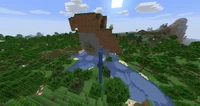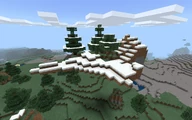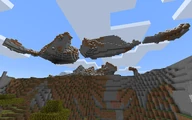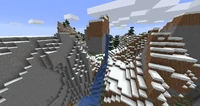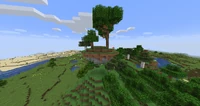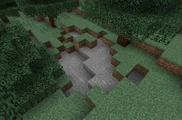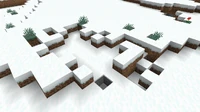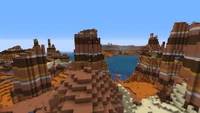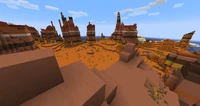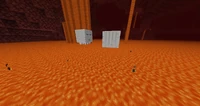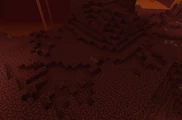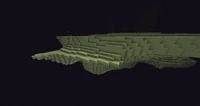This page lists generated terrain features that are created in a Minecraft world.
Overworld[]
Hill[]
Hills can contain extreme slopes, cliffs and caves. On an amplified world, hills are extremely common in all biomes except oceans.
Mountain[]
Mountains are high elevation terrain that has jagged peaks and higher land.
Cliff[]
Cliffs are steep vertical slopes that can sometimes generate beside an ocean or a big lake.
Fjord[]
Fjords happen when rivers cut through high-medium elevation terrain. Rivers are deeper here than usual.
Floating island[]
Floating islands are structures that float in mid-air. Floating islands are normally just small chunks of floating dirt and stone found near cliffs, but on rare occasions they can be large structures that even have springs and trees on them. Floating islands are most frequently found in windswept hills biomes and their variants, as well windswept savannas.
Noise cave[]
Surface[]
Surface layer[]
The uppermost layers of the terrain are converted to a biome-dependent material: usually grass blocks and dirt, or sand in deserts and beaches. Podzol is found in giant tree taiga, mycelium in mushroom field biomes, and red sand is found in the badlands biome. Sandstone is generated under the sand.
Erosion[]
Occasionally, instead of being converted to dirt or sand, the top layer is stripped away, leaving an 'erosion' (aka. 'basin') of bare stone. They occur more often in forests or plains and occasionally contain water. Commonly, minerals can be found in these, generally coal ore and iron ore. If generated in a Badlands biome, gold ore can also be seen.
Strip[]
Strips are long stretches of blocks in certain biomes that replace the typical surface materials in these biomes. They can occur in stony shore biomes as strips of gravel, in stony peaks biomes as strips of calcite, in frozen peaks biomes as strips of packed ice, as well as in grove and snowy slopes biomes as strips of powder snow.
Hoodoo[]
Hoodoos are tall spike-like structures found in badlands, consisting of six colors of terracotta. While this structure is found exclusively in eroded badlands, all badlands biomes actually have this structure, but set to false except for eroded badlands and can occasionally pass altitude layer 100.
Iceberg[]
An iceberg is a large terrain feature composed of packed ice and snow block. There is also a feature known as an iceberg, see Iceberg (feature).
Icebergs generate in frozen oceans and deep frozen oceans. They consist of packed ice, and can be topped with snow block. Icebergs generate in a wide variety of shapes and sizes, ranging from small islands to giant mountain-like icebergs. They can also generate with cave-like holes in them, which sometimes pass through to the other side of the iceberg.
There are often blue ice features attached to them.
Carvers[]
- Carver caves – large tunnels found underground in the Overworld and the Nether.
- Canyons – deep long cracks
Others[]
The Nether[]
Lava sea[]
Lava seas are found at and below level 31 in the Nether. They make a large portion of the Nether and are extremely common. They can stretch for hundreds of blocks in any direction, and are usually bordered by netherrack, or occasionally soul sand, gravel and/or magma blocks. Striders can spawn in lava seas.
Unlike with Overworld oceans, lava seas are not handled as a biome.[1]
A few ghasts swimming in a lava sea.
Nether erosions[]
In the Nether, erosions generate the same size and shape as they do in the Overworld. Unlike their Overworld counterparts, however, Nether erosions replace the ground with netherrack instead of stone. Nether erosions can also expose ores, mainly nether quartz ore and nether gold ore.
Notably, erosions generate independent of the y-coordinate; if a erosion generates in an overhang in the Nether, an identical erosion is guaranteed to generate at the exact same x and z coordinates on the ground below such an overhang.
An erosion in a crimson forest, exposing nether quartz ore blob.
An erosion in a warped forest.
An erosion in a nether wastes.
Carver[]
- Carver caves – large tunnels found underground in the Overworld and the Nether.
The End[]
Central island[]
The center of the End is a large, asteroid-like island composed entirely of end stone, floating in the void. At a distance of 1000 blocks away, an endless expanse of more islands begins, away from the main island. These consist of large islands, about the size of the main island, and smaller ones, which are usually thin and small.
Outer island[]
The outer end islands are found 1000 blocks away from the central island. They vary in size from large islands to smaller "mini islands". Generated structures such as end cities and end ships spawn here, along with chorus plants and erosions. The player can be taken to the end islands through the end gateway.
Obsidian platform[]
The obsidian platform is a square of obsidian that generates when an entity enters the End.
End erosions[]
Erosions generate in the End as they would in the Overworld and the Nether, with the exception being that they never expose any ores. End erosions may generate on both the central island and outer islands, and chorus plants can occasionally take root in the erosions.
History[]
Reason: Add all 1.17-1.19 terrain feature
| Java Edition pre-Classic | |||||
|---|---|---|---|---|---|
| Cave game tech test | Development on "Cave Game" started; caverns added. | ||||
| Java Edition Classic | |||||
| 0.0.12a | Added ocean around map. | ||||
| 0.0.14a | Added trees. At this point they were simply stumps covered with a thin leaf layer. | ||||
| 0.0.15a (Multiplayer Test 1) | Trees have a new shape. | ||||
| August 25, 2009 | Video uploaded showing changed cavern generation; longer and narrower caverns, and bigger caves the deeper you travel. | ||||
| Surface lava lakes shown to be possible but unlikely, despite existing as early as 0.0.12a_03. | |||||
| Java Edition Infdev | |||||
| 20100227-1 | Temporarily removed caves, trees and ores to test basic infinite world functionality. | ||||
| 20100320 | Re-added trees and ores. | ||||
| 20100325 | Re-added caves. | ||||
| Redid mineral blobs | |||||
| 20100327 | Caves are removed again. | ||||
| 20100616 | Caves are now again implemented. | ||||
| Java Edition Alpha | |||||
| v1.0.1 | Caves can now be far bigger and more expansive. | ||||
| v1.2.0 | preview | Added the Nether but not all Nether-related generated structures. | |||
| v1.2.6 | Added small lakes and rare lava pools, both on the surface and randomly in caves. | ||||
| Java Edition Beta | |||||
| 1.8 | Pre-release | Added huge mushrooms. | |||
| Added river biomes and vast oceans. | |||||
| Sand and gravel beaches removed due to the changes in the terrain generation algorithm. | |||||
| Java Edition | |||||
| 1.0.0 | Beta 1.9 Prerelease 4 | Added the End and End-related main island generated structures, including the End island, the obsidian platform, the end spikes and the exit portal. | |||
| 1.1 | 12w01a | Sand beaches have made a return, but the way they look and generate are not the same as before. | |||
| 1.2.1 | 12w07a | The generation of beaches has been greatly improved. | |||
| 1.6.1 | 13w17a | Water oases no longer generate in deserts. | |||
| 1.7.2 | 13w36a | Gravel beaches have been returned to the terrain. | |||
| Mountains now generate as part of the "M" biome variants. | |||||
| The desert oases appear in the desert M biome. | |||||
| Moss stone boulders were added. | |||||
| 1.9 | 15w31a | Added the outer islands of the End. | |||
| Added chorus plants. | |||||
| Added the end gateway portal. | |||||
| 1.13 | 18w08a | Caves and canyons can now generate underwater. | |||
| Frozen Ocean have made a return, but without customized, they look and generate, but are not the same unused. | |||||
| 18w10d | Added coral reefs. | ||||
| 18w15a | Added icebergs. | ||||
| 1.16 | 20w06a | Added basalt pillars. | |||
| Pocket Edition Alpha | |||||
| v0.1.0 | Added sand and gravel beaches, oceans, frozen oceans, cliffs, mountains, erosions, blobs, springs, and trees. | ||||
| v0.9.0 | build 1 | Added caves, lava pools, rivers, huge mushrooms, moss stone boulders, ice patches, and ice spikes. | |||
| Frozen oceans no longer generate. | |||||
| Removed gravel beaches. | |||||
| v0.12.1 | build 1 | Added the Nether, along with lava oceans, glowstone clusters, soul sand beaches, hidden lava, gravel beaches, and nether quartz blobs. | |||
| Pocket Edition | |||||
| 1.0.0 | alpha 0.17.0.1 | Added the End and End-related generated structures, including the End islands, the obsidian platform, the obsidian towers, the end fountain, end cities, end gateways, and chorus trees. | |||
| Bedrock Edition | |||||
| 1.2.0 | beta 1.2.0.2 | Added ravines. | |||
| 1.4.0 | beta 1.2.14.2 | Added icebergs. | |||
| Added coral reefs. | |||||
| Ravines can now generate underwater. | |||||
| Frozen oceans have made a return, but the way they look and generate are not the same as before. | |||||
| beta 1.2.20.1 | Caves can now generate underwater. | ||||
| 1.16.0 | beta 1.16.0.51 | Added basalt pillars. | |||
| Legacy Console Edition | |||||
| TU5 | CU1 | 1.0 | Patch 1 | 1.0.1 | Added ravines. |
| Sand and gravel beaches removed due to the changes in the terrain generation algorithm. | |||||
| TU9 | Added the End along with End-related structures such as the End island, the obsidian platform, the obsidian towers, and the end fountain. | ||||
| Sand beaches have made a return, but the way they look and generate is not the same as before. | |||||
| TU19 | CU7 | 1.12 | Water oases no longer generate in deserts. | ||
| TU69 | 1.76 | Patch 38 | Added coral reefs and underwater caves and ravines. | ||
| New Nintendo 3DS Edition | |||||
| 1.7.10 | Added chorus plants. | ||||












